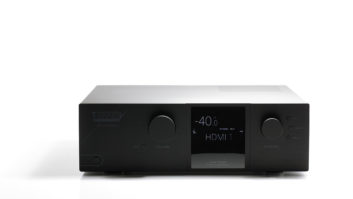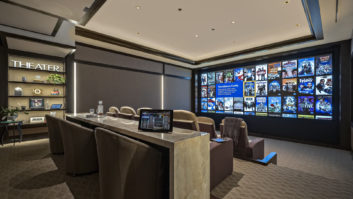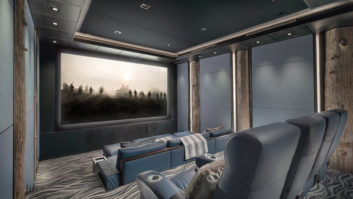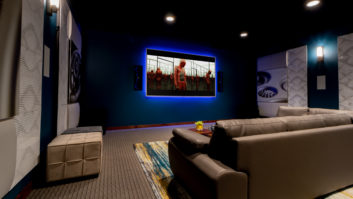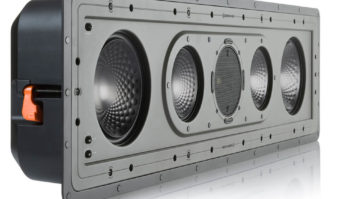When you think about our industry—especially the high end of it—there is no shortage of luxury products in virtually every category.
Stroll through the Venetian Las Vegas hotel suites at CES and you can encounter six-figure turntables that are so beautifully designed that they might be more at home in an art exhibit at MoMA. These glorious beasts are a striking mash-up of technology, precision craftsmanship, and just shear heft, all designed for the sole purpose of turning a (180-gram) piece of vinyl precisely 33 and one third (or 45, or 78) revolutions per minute with as much platter isolation as humanly possible.
Step into other listening suites and you can experience loudspeakers more expensive than many homes, featuring exotic cabinetry and driver materials—some crafted from very specific trees only found in very remote forests and only harvested at very certain times of year by master wood artisans, to lock in freshness—designed to play frequencies that no human ear could possibly hear.
If you want luxury wiring and cabling to connect your system, you’ve got many options from which to choose. Whereas a gold-plated connector used to be the height of interconnect luxury, today that is viewed as merely the starting point. Truly high-performance systems employ power cabling as thick as a fire hose, speaker cabling with special wiring and braiding designed to confuse audio gnomes and gremlins from interfering with perfection, and interconnects made from Six Sigma-levels of pure silver that would make NASA green with envy.
We have ultra-fancy remote controls and automation systems, seating made from the finest Italian leathers from cows that trace their ancestry back to the throne, audio processing that can dish out more computing horsepower than Deep Blue, and power amplifiers milled from the purest hunks of aluminum with enough power to drive a small city for a weekend.
But where’s the luxury video?

Image: Thinkstock
Sure, we still have high-end displays. I mean, LG’s new 4K OLED is so gorgeous it will have you simultaneously looking for a room of suitable darkness in which to fully worship at the altar of its infinite blackness AND be checking the Dark Web for the going price of selling an unused organ to pay for the thing. Sony, Christie, Barco, and Digital Projection have all advanced the state of 4K video projection to levels that make us just shake our heads and silently chuckle over what we thought “good” video quality was even a couple of years back.
No, it’s high-end video source devices that the industry seems to have abandoned.
Think about it; for all of these ultra-high-end rooms that we design and install, most of them are driven by a Blu-ray player that provides essentially the same experience whether it’s got $1,000 or $100,000 worth of gear behind it. And most of the players these days are little more than junky, plastic boxes not much bigger than the discs themselves, and certainly not designed to give any sense of “quality” or “performance” to the casual rack observer.
Sure, some players are housed in fancier cases—Oppo has raised product packaging and presentation to an art form—maybe featuring some fancier parts like upgraded DACs or video processing, but they all basically deliver just the same old user experience: get up, find the disc, put it in the player, wait for it to load, get through the menus, press play.
The paradigm has changed only slightly with the new slate of UHD players. First off, the height of a “luxury” UHD player is currently a $400 Samsung that comes with a god-awful remote control that—at least with my model—the unit frequently stops responding to, requiring a power cycle to restore operation. (The Philips UHD player is so disappointingly cheap looking, I’m still kind of half-hoping it turns out to be a joke.) The one thing UHD players/discs seem to have gotten right so far is to get rid of all the ads and trailers and let you just get straight into the film. (Look, I’m already obviously watching a Blu-ray disc, DEG you don’t need to keep showing me ads espousing the virtues of the format! I got it. I’m on board!)
Many of our customers have eschewed the quality of disc-based media altogether in favor of streaming. Devices like Roku, Amazon Fire Stick, Apple TV, or TVs with built-in apps serve up a steady stream of content via Netflix, Hulu, Amazon, or Vudu. (Admittedly, Vudu’s HDX quality is pretty terrific and is the clear quality leader in streaming. If they ever get around to supporting lossless audio, they might even win my cold-cold heart over…)
When you think about it, there are really only two high-end video products out there: Kaleidescape and PRIMA Cinema.
PRIMA is undoubtedly awesome. You can read my full review of the system here. It’s the kind of device that you start getting all giddy and excited about when you describe it to others and they’re all, “Really? You can watch that in your house, right now?! That’s amazing.” PRIMA not only offers the most unique home movie watching experience, it also features a terrific user interface, has stunning build quality, and delivers gorgeous quality video.
PRIMA features a wonderful “Coming Soon” section of its interface that lets users browse coming attractions and view trailers just like the real, going-to-the-movies experience (without all of the people around you talking and being on their cell phones and the complete and utter lack of any craft IPAs or top-shelf single malt scotch at the concessions stand). The downside is that PRIMA costs about the same as a decent automobile, meaning that the client base is going to be limited to recent Mega Millions lottery winners and the one percent of the one-percenters.
Far more affordable is Kaleidescape’s new Strato 4K movie player. At $4,495, Strato hits a price point that, while not cheap, is still very realistic to budget into a $20,000 theater. With this device, users can enjoy a legendary user interface, along with the highest quality 4K/HDR video (and audio!) currently available outside a Hollywood mastering studio. With a click of a button, users can download movies in full quality that are available to watch at any time—instantly, with no getting up—and that will never suffer for buffering issues.
Kaleidescape users also enjoy things like bookmarked iconic scenes from movies, letting them jump straight to those key moments in a movie for times when you feel like “sampling” before or after a movie night. I mean, who doesn’t love to end the evening with a little “Laxative Revenge” from Dumb & Dumber or “Porno Password” from The Cable Guy?!
If $4,495 seems slightly out of reach, Kaleidescape’s Alto with 6TB of storage clocks in at $3,295. Sure, it doesn’t do 4K, but it includes all of the other performance and browsing features of bigger-brother Kaleidescape players, lets users download any of the thousands of Blu-ray (and DVD) quality titles from Kaleidescape’s online movie store, and has a disc drive that makes it one heck of an awesome Blu-ray player in its own right!
The only reason why I can think of for such a lack of high-end video products is that video is just a lot tougher than audio. It’s not easy working with studios to create relationships and writing your own software for the purpose-built computers that are Blu-ray players (and not just putting someone else’s player inside your case.)
According to Kaleidescape’s co-founder and CEO, Cheena Srinivasan, “There is a lot of software with ordinary BD players, but almost all commodity players just license the binary code and don’t bother with any customization. I don’t know how many Blu-ray player manufacturers actually license source code to develop their product, but my guess is [Kaleidescape is] one of the very few in the world.”
Kaleidescape began shipping Blu-ray movie servers in 2011 and started development on that product a couple of years prior to that. It is that learning curve that translates its ability to be a premium platform and content retailer.
A vast majority of what the Kaleidescape experience is about comes from software features. “Servers and movie players run our proprietary kOS operating system,” Srinivasan said. “We have software to deal with storage management, content management, internet services, content delivery, and our Movie Store, onscreen display, media playback, large amounts of content security/protection, log database, system grouping and automated software updates to keep all these processes humming efficiently behind the scenes. This is what makes the Kaleidescape experience so unique.”
The end result and overall customer enjoyment and experience is what sets our professionally installed systems apart, and a luxury video solution should definitely be part of that equation.
